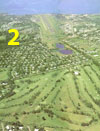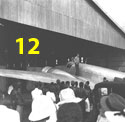 |
September 11, 2000
This Research Bulletin presents sixteen photos taken in Lae, New Guinea during the time Earhart and Noonan were there (June 29 – July 2, 1937). Several of the photos here have never before, to our knowledge, been shown publicly. Others are often identified as showing “the final takeoff” when, in fact, they probably do not.
Each photo is represented with a numbered thumbnail. Click on the thumbnail to open a full-sized image in a new window.
In attempting to place the photos in space and time it is useful to have an understanding of how the airfield at Lae was laid out. Unfortunately, we have been unable to find an aerial view of the strip taken in 1937 but more recent photos show the basic configuration of the runway and facilities.

 The
main facilities are on the east (at left in the photos 1 & 2) side of the
field about two-thirds of the way down Runway 15. This picture seems to have been
taken at an earlier time than the first photo. The taxiway may still be unpaved
and the large runup area off to the west (right) side of the runway has not
yet been built.
The
main facilities are on the east (at left in the photos 1 & 2) side of the
field about two-thirds of the way down Runway 15. This picture seems to have been
taken at an earlier time than the first photo. The taxiway may still be unpaved
and the large runup area off to the west (right) side of the runway has not
yet been built.
 Photo
#3 is from Ann Pellegreno’s book World Flight – The Earhart
Trail, and was taken on June 30, 1967. It shows the hills that border
the airfield and no taxiway is apparent. Pellegreno says that the Guinea
Airways hangar, rebuilt after the war, is “nearer the seaward end of the runway” than
the main terminal.
Photo
#3 is from Ann Pellegreno’s book World Flight – The Earhart
Trail, and was taken on June 30, 1967. It shows the hills that border
the airfield and no taxiway is apparent. Pellegreno says that the Guinea
Airways hangar, rebuilt after the war, is “nearer the seaward end of the runway” than
the main terminal.
 The
earliest photo (#4) we have of the airstrip at Lae was taken by the U.S.
Army Air Force on July 31, 1943 soon after the field was recaptured. Japanese
aircraft have been numbered and identified on the photo by 5th Air Force
Intelligence. There is considerable bomb damage to the field and, not surprisingly,
no standing hangars are in evidence but, based on the 1967 photo and Pellegreno’s
description, the Guinea Airways hangar probably once stood where the red
rectangle is shown. The unpaved runway and taxiway are easily seen and
appear to be the same length (3,000 feet) they were in 1937.
The
earliest photo (#4) we have of the airstrip at Lae was taken by the U.S.
Army Air Force on July 31, 1943 soon after the field was recaptured. Japanese
aircraft have been numbered and identified on the photo by 5th Air Force
Intelligence. There is considerable bomb damage to the field and, not surprisingly,
no standing hangars are in evidence but, based on the 1967 photo and Pellegreno’s
description, the Guinea Airways hangar probably once stood where the red
rectangle is shown. The unpaved runway and taxiway are easily seen and
appear to be the same length (3,000 feet) they were in 1937.
 Photo #5, of uncertain origin, has been said to show the Earhart aircraft
on its final takeoff from Lae. Although the aircraft does appear to be NR16020
and the airfield is clearly Lae (compare the background to the Lae takeoff
film), this appears to be an arrival rather than a departure. The airplane
is near the departure end of Runway 15 and is in the three-point attitude (meaning
that all three wheels are on the ground). At this point in the final takeoff
the aircraft was in the two-point attitude (tail up) and ready to fly. This
airplane appears to be taxiing, which would be consistent with an arrival on
Runway 15 and subsequent taxi to the Guinea Airways facility.
Photo #5, of uncertain origin, has been said to show the Earhart aircraft
on its final takeoff from Lae. Although the aircraft does appear to be NR16020
and the airfield is clearly Lae (compare the background to the Lae takeoff
film), this appears to be an arrival rather than a departure. The airplane
is near the departure end of Runway 15 and is in the three-point attitude (meaning
that all three wheels are on the ground). At this point in the final takeoff
the aircraft was in the two-point attitude (tail up) and ready to fly. This
airplane appears to be taxiing, which would be consistent with an arrival on
Runway 15 and subsequent taxi to the Guinea Airways facility.
The question becomes, which arrival? Earhart’s Electra arrived at Lae twice: once on June 29, 1937 at about 2 p.m. after a seven hour, forty minute flight from Darwin, Australia; and once on July 1, 1937 at about 7 a.m. after a thirty minute local test flight.

 This
photo, again of uncertain origin, also has been said to show the final takeoff
but it was quite obviously taken moments after the Alan Board photo immediately
above. The man in the shorts and white socks has caught up to the man in
coveralls, who appears to be pulling down on the airplane’s aileron
which would, of course, wiggle the control yoke in Amelia's hand, thus attracting
her attention. The absence of trees in the background indicates that the airplane
has made a left turn since the previous photo and is now headed in the direction
of the Guinea Airways hangar. Because it seems reasonable that AE would be
more likely to need taxiing guidance on her initial arrival than after the
test flight, these photos were most probably taken on June 29th. Note also
that in the few moments between the two photos, the loop antenna over the cockpit
has been rotated 90 degrees. It is also worth noting that in this photo both
belly antenna masts can be seen.
This
photo, again of uncertain origin, also has been said to show the final takeoff
but it was quite obviously taken moments after the Alan Board photo immediately
above. The man in the shorts and white socks has caught up to the man in
coveralls, who appears to be pulling down on the airplane’s aileron
which would, of course, wiggle the control yoke in Amelia's hand, thus attracting
her attention. The absence of trees in the background indicates that the airplane
has made a left turn since the previous photo and is now headed in the direction
of the Guinea Airways hangar. Because it seems reasonable that AE would be
more likely to need taxiing guidance on her initial arrival than after the
test flight, these photos were most probably taken on June 29th. Note also
that in the few moments between the two photos, the loop antenna over the cockpit
has been rotated 90 degrees. It is also worth noting that in this photo both
belly antenna masts can be seen. When
the flight first arrived at Lae the airplane was taxied up and nosed into
the Guinea Airways hangar. A welcoming crowd gathered at the base of the
left wing and many photos were snapped by a variety of onlookers as Fred
and AE emerged. (Note what seems to be the same man in the sun helmet in
the left foreground.) This photo, taken by Alan Board, seems to be the earliest
of the ones we’ve seen. What is interesting about it is that Noonan has obviously
exited the airplane first. Contrary to legend, Fred usually rode in the copilot’s
seat, not back in the cabin, but to get out first he had to clamber around
or over AE to clear the stage for her grand entrance.
When
the flight first arrived at Lae the airplane was taxied up and nosed into
the Guinea Airways hangar. A welcoming crowd gathered at the base of the
left wing and many photos were snapped by a variety of onlookers as Fred
and AE emerged. (Note what seems to be the same man in the sun helmet in
the left foreground.) This photo, taken by Alan Board, seems to be the earliest
of the ones we’ve seen. What is interesting about it is that Noonan has obviously
exited the airplane first. Contrary to legend, Fred usually rode in the copilot’s
seat, not back in the cabin, but to get out first he had to clamber around
or over AE to clear the stage for her grand entrance. Photo
#10 – AE exits the hatch. Good shot of her blucher oxford flying shoes.
Photo
#10 – AE exits the hatch. Good shot of her blucher oxford flying shoes.
 Number
11, another
Alan Board photo. AE starts down the wing. Fred waits below, apparently
ready to help her down.
Number
11, another
Alan Board photo. AE starts down the wing. Fred waits below, apparently
ready to help her down.
 Photo
#12, taken by Guinea Airways employee Aubrey Koch, seems to be next in the
sequence. AE has removed her leather jacket and has closed the cockpit hatch.
Fred still waits at the base of the wing.
Photo
#12, taken by Guinea Airways employee Aubrey Koch, seems to be next in the
sequence. AE has removed her leather jacket and has closed the cockpit hatch.
Fred still waits at the base of the wing.
 Photo
#13, AE is on the ground talking to Guinea Airways manager Eric Chater. Fred
is at her immediate left. The tall man in the right foreground appears in several
other photos. The cockpit hatch is open again.
Photo
#13, AE is on the ground talking to Guinea Airways manager Eric Chater. Fred
is at her immediate left. The tall man in the right foreground appears in several
other photos. The cockpit hatch is open again.

 The
conversation has moved back close to the tail of the airplane. AE is still
talking to Chater and the tall man is still looking on.
The
conversation has moved back close to the tail of the airplane. AE is still
talking to Chater and the tall man is still looking on.
It’s photo-op time. Mr. and Mrs. Chater pose with the famous flyers. Fred has a smoke.

 Aubrey
Koch took photo #16 of AE and Fred posing with more local people. That’s
Mrs. Chater again in the polka-dot dress. The man between AE and Fred is
said to be Mr. Jacobs of the New Guinea Gold Mining Company. The others are
unidentified.
Aubrey
Koch took photo #16 of AE and Fred posing with more local people. That’s
Mrs. Chater again in the polka-dot dress. The man between AE and Fred is
said to be Mr. Jacobs of the New Guinea Gold Mining Company. The others are
unidentified.
After the crowds dispersed Alan Board took photo #17of the aircraft nosed into the hangar. All the antennas can be seen in place.

 Number
18, left
rear view of the Electra nosed into the Guinea Airways hangar. Note the step
ladder in front of the port engine.
Number
18, left
rear view of the Electra nosed into the Guinea Airways hangar. Note the step
ladder in front of the port engine.
That’s Capt. Noonan on the step ladder in #19 by Alan Board, helping someone work on the prop hub while another man looks on.
 Alan
Board’s photo of the final takeoff was snapped just before the aircraft left
the ground. The vine-covered “Y” shaped dead tree on the left in the photo
is a useful landmark. It’s the last tree before the end of the runway
and can be seen in the takeoff film both as the airplane begins to taxi out
and as it leaves the ground at the end of the takeoff run. Given the length
of the runway at Lae it is inconceivable that the airplane would still be on
the ground at this point in anything but a desperately overloaded takeoff.
There appears to be no reasonable doubt that both the film and this still photo
show the aircraft taking off on July 2, 1937. (See The
Lost Antenna and The Lost Antenna
II for the significance of these photos.)
Alan
Board’s photo of the final takeoff was snapped just before the aircraft left
the ground. The vine-covered “Y” shaped dead tree on the left in the photo
is a useful landmark. It’s the last tree before the end of the runway
and can be seen in the takeoff film both as the airplane begins to taxi out
and as it leaves the ground at the end of the takeoff run. Given the length
of the runway at Lae it is inconceivable that the airplane would still be on
the ground at this point in anything but a desperately overloaded takeoff.
There appears to be no reasonable doubt that both the film and this still photo
show the aircraft taking off on July 2, 1937. (See The
Lost Antenna and The Lost Antenna
II for the significance of these photos.)